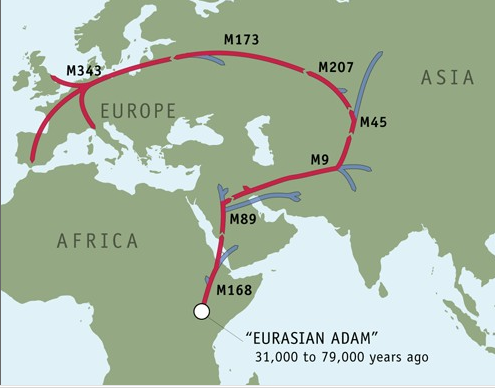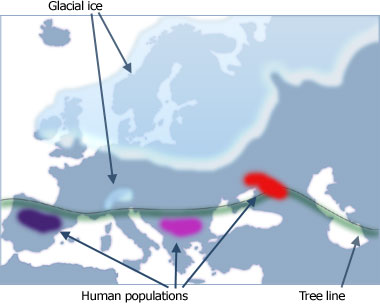
Ancient Ancestry
Paternal History
The following map follows the “out of Africa” theory that posits that the present homo sapiens came from Africa and the history of the movement can be verified by the markers of the y-chromosome. Mutations in the human genome do occur and these mutations remain in the y-chromosome in all descendants.
In this theory, the ancient ancestry of homo sapiens had early beginnings with the M168 marker which was first apparent about 60,000 years ago in Africa and is common to all males today, with rare exceptions in Africa.
The next mutation resulted in the M89 marker about 55,000 years ago in the Arabian peninusula. 90% of the current male population have this marker.
A number of M89 ancestors continued to follow the great herds of buffalo, antelope, woolly mammoths, and other game through what is now modern-day Iran to the vast steppes of Central Asia, For the M89s remaining in the Middle East the climate shifted once again and became colder and more arid. These ancestors had two options: remain in the Middle East, or move on.
A number of M89 continued to follow the great herds of buffalo, antelope, woolly mammoths, and other game through what is now modern-day Iran to the vast steppes of Central Asia, where 40,000 years ago another mutation occurred, labelled M9.
The M9s, seasoned hunters, followed the herds ever eastward, along the vast superhighway of Eurasian steppe. Eventually their path was blocked by the massive mountain ranges of south Central Asia the Hindu Kush, the Tian Shan and the Himalayas. The three mountain ranges meet in a region known as the “Pamir Knot”, located in present-day Tajikstan. Here the tribes of hunters split into two groups. Some moved north into Central Asia, others moved south into what is now Pakistan and the Indian sub-continent.
The excitement for the M9s continues as that part of the tribe continue the march northwards into the area currently designated the Hindu Kush, southern Siberia, Kazakhstan and Uzbekistan, when another significant mutation occurred around 35,000 years ago, M45, Resourcefulness and ability to adapt was critical to survival during the last Ice Age in Siberia, a region where no other hominid species is known to have lived.
After spending considerable time in Central Asia, refining skills to survive in harsh new conditions and exploit new resources, a group from the Central Asian Clan began to head west towards Europe. An individual in this clan carried the new M207 mutation on his Y-chromosome some 30-35,000 years ago. His descendants ultimately split into two distinct groups, with one continuing on to Europe, making this man the ancestor of most western European men alive today. A further mutation, M173, occurred on the way to Europe about 25,000 years ago
Around 17,000-20,000 years ago, a descendant of the clan making its way into Europe gave rise to marker M343. These people dominated the human expansion into Europe, the Cro-Magnon. It is believed that Cro-Magnon Man lived alongside the Neanderthals, and according to some expert opinion, caused the latter's extinction, although there is evidence they co-existed for some time.

Enclaves of humanity in Europe during the last Ice Age
When the ice came again in the latest glacial period (18-10,000 years ago) the tribes were grouped in three main areas: one sheltered in the Iberian peninsula, and another in the Eurasian Steppes north of the Black and Caspian Seas (these were the first speakers of the Indo-European language around 7,000 years ago), and one group in northern Greece/Yugosla. The first groups sheltering in the Iberian peninsula created the famous cave-paintings in France and Spain.
When the ice melted (about 10,000 years ago) the groups moved northwards - descendants of M343 populating most of Western Europe, in general as far east as northern Germany. This is the last one noted in the map above.
The next significant mutation in my ancestry is M269 mutation of about 6,000 years ago, which is about the time of the early Proto-Indo-European language. Today, this lineage accounts for the majority of the male population in Europe
My markers From National Geographic and other sources continue from M269 as follows:
M269 (8,000 years ago) > P312 (6,000 years ago) > DF27 (4,500 years ago) > Z225 (3,000 years ago?) , The last one is the name of my haplogroup and only 0.3% of the people tested by National Geographic are in that haplogroup.
Maternal Ancestry
There is a similar map of my maternal heritage. In the following map they do not list the mitrochondrial DNA marker but the haplogroups defined by them.
The common direct maternal ancestor to all women alive today was born in East Africa around 150,000 years ago. Dubbed “Mitochondrial Eve” by the popular press, she represents the root of the human family tree.
The L3 branch kept moving northward, eventually leaving the African continent completely. These people gave rise to two important macro-haplogroups (M and N) that went on to populate the rest of the world.
Why would humans have first ventured out of the familiar African hunting grounds and into unexplored lands? It is likely that a fluctuation in climate may have provided the impetus for your ancestors’ exodus out of Africa. The African Ice Age was characterized by drought rather than by cold. Around 50,000 years ago the ice sheets of northern Europe began to melt, introducing a period of warmer temperatures and moister climate in Africa. Parts of the inhospitable Sahara briefly became habitable. As the drought-ridden desert changed to savanna, the animals these ancestors hunted expanded their range and began moving through the newly emerging green corridor of grasslands. These nomadic ancestors followed the good weather and plentiful game northward across this Saharan Gateway, although the exact route they followed remains to be determined.
The early members of the N branch lived in the eastern Mediterranean region and western Asia, where they likely coexisted for a time with other hominids such as Neanderthals. Excavations in Israel’s Kebara Cave (Mount Carmel) have unearthed Neanderthal skeletons as recent as 60,000 years old, indicating that there was both geographic and temporal overlap of these two hominids. This likely accounts for the presence of Neanderthal DNA in people living outside of Africa. (1.5% for me.)
After several thousand years in the Near East, members of the group began moving into unexplored nearby territories, following large herds of migrating game across vast plains. These groups broke into several directions and made their way into territories surrounding the Near East.
Today, haplogroup N individuals who headed west are prevalent in Turkey and the eastern Mediterranean, they are found further east in parts of Central Asia and the Indus Valley of Pakistan and India. And members of my haplogroup who headed north out of the Levant across the Caucasus Mountains have remained in southeastern Europe and the Balkans. Importantly, descendants of these people eventually went on to populate the rest of Europe, and today comprise the most frequent mitochondrial lineages found there.
The story of haplogroup R is complicated, however, because these individuals can be found almost everywhere, and because their origin is quite ancient. In fact, the ancestor of haplogroup R lived relatively soon after humans moved out of Africa during the second wave, and her descendants undertook many of the same migrations as her own group, N.
Descending from haplogroup R were a group of individuals who formed a western Eurasian lineage. The descendants of pre-HV live in high frequencies in the Anatolian-Caucasus region and Iran. While members of this group can also be found in the Indus Valley near the Pakistan-India border, their presence is considered the result of a subsequent migration eastward of individuals out of the Near East.
Haplogroup HV is a west Eurasian haplogroup found throughout the Near East, including Anatolia (present-day Turkey) and the Caucasus Mountains of southern Russia and the republic of Georgia. It is also found in parts of East Africa, particularly in Ethiopia, where its presence there indicates recent Near Eastern gene flow, likely the result of the Arab slave trade over the last two millennia.
Much earlier, around 30,000 years ago, some members of HV moved north across the Caucasus Mountains and west across Anatolia, their lineages being carried into Europe for the first time by the Cro-Magnon. Their arrival in Europe heralded the end of the era of the Neanderthals, a hominid species that inhabited Europe and parts of western Asia from about 230,000 to 29,000 years ago. Better communication skills, weapons, and resourcefulness probably enabled them to outcompete Neanderthals for scarce resources. Importantly, some descendants of HV had already broken off and formed their own group, haplogroup H, and continued the push into Western Europe.
This wave of migration of the H haplogroup into western Europe marked the appearance and spread of what archaeologists call the Aurignacian culture, a culture distinguished by significant innovations in methods of manufacturing tools, standardization of tools, and use of a broader set of tool types, such as end-scrapers for preparing animal skins and tools for woodworking.
Around 15,000 to 20,000 years ago, colder temperatures and a drier global climate locked much of the world’s fresh water at the polar ice caps, making living conditions near impossible for much of the northern hemisphere. Early Europeans retreated to the warmer climates of the Iberian Peninsula, Italy, and the Balkans, where they waited out the cold spell. Their population sizes were drastically reduced, and much of the genetic diversity that had previously existed in Europe was lost.
Today haplogroup H comprises 40 to 60 percent of the gene pool of most European populations. In Rome and Athens, for example, the frequency of H is around 40 percent of the entire population, and it exhibits similar frequencies throughout western Europe. Moving eastward the frequencies of H gradually decreases, clearly illustrating the migratory path these settlers followed as they left the Iberian Peninsula after the ice sheets had receded.
I have been classified in one the H subgroups, namely the H17A1 haplogroup.